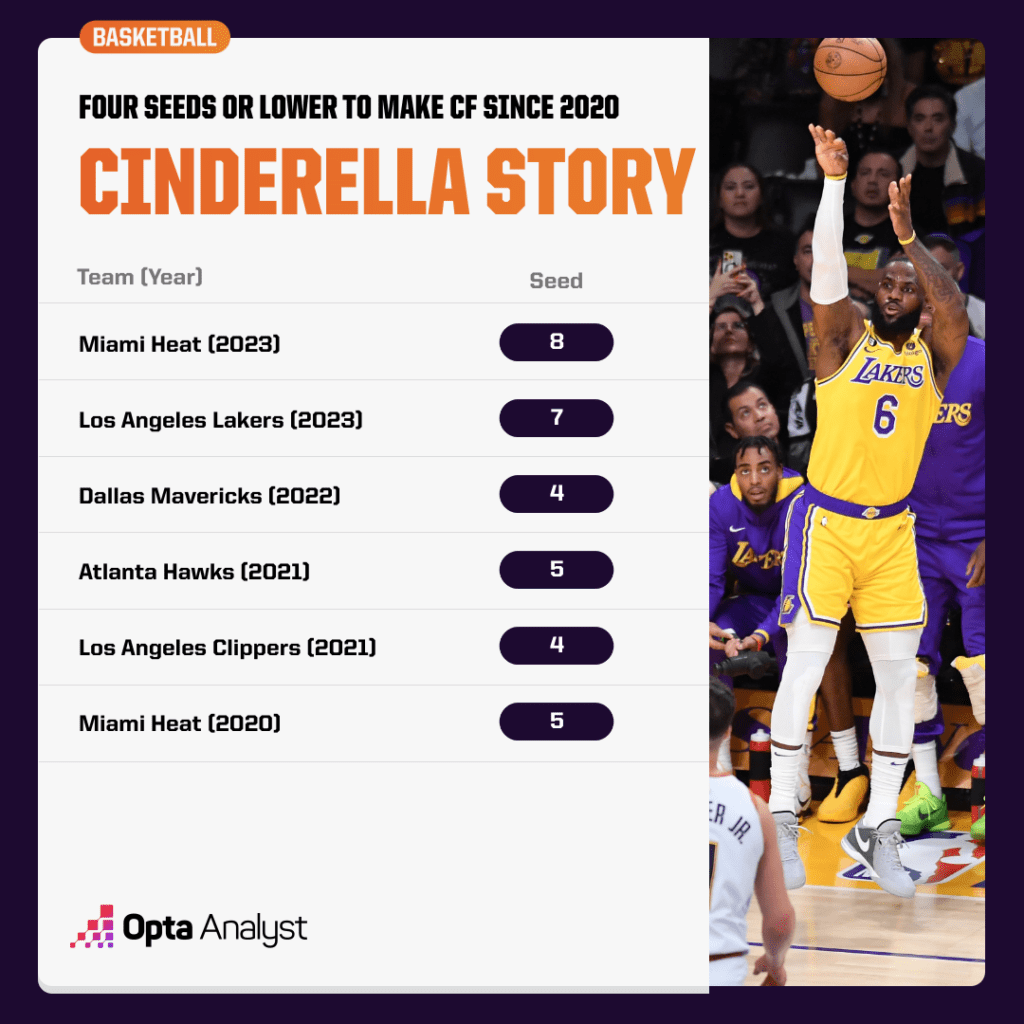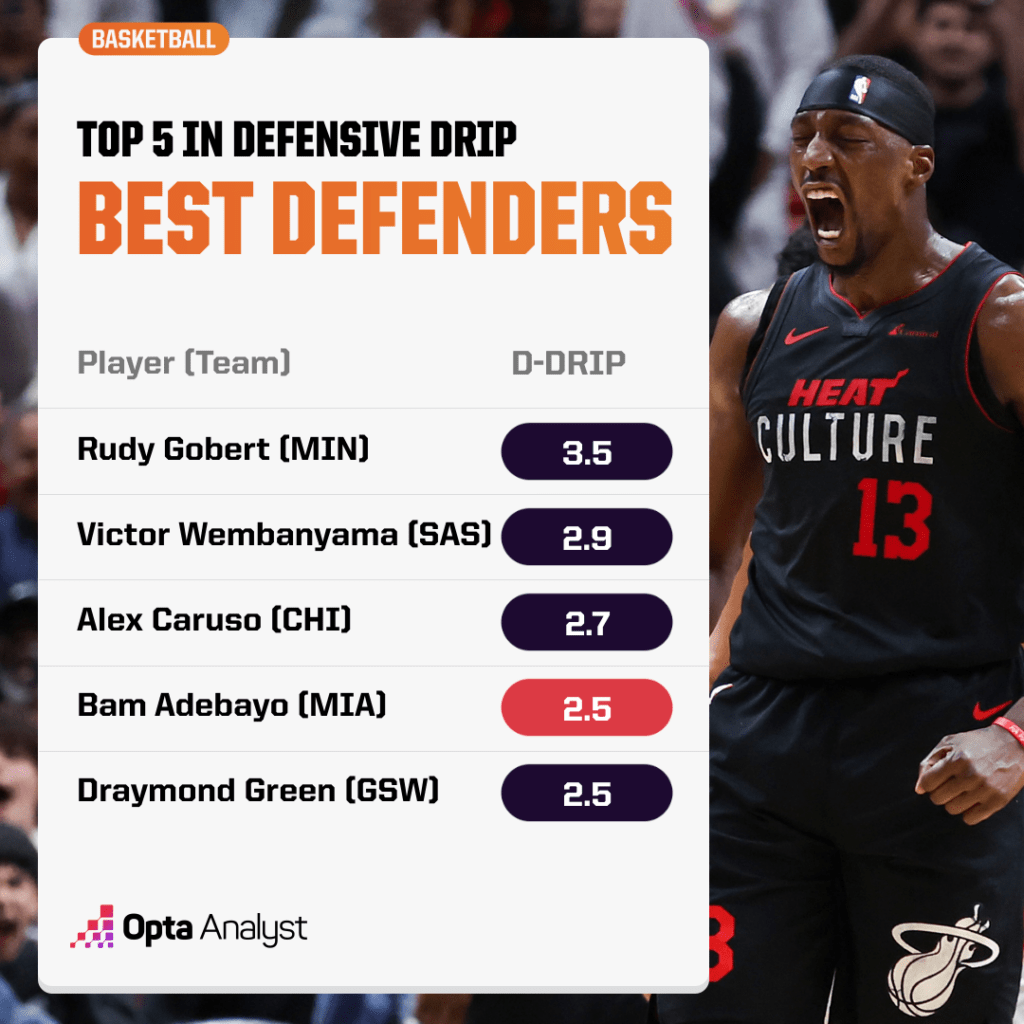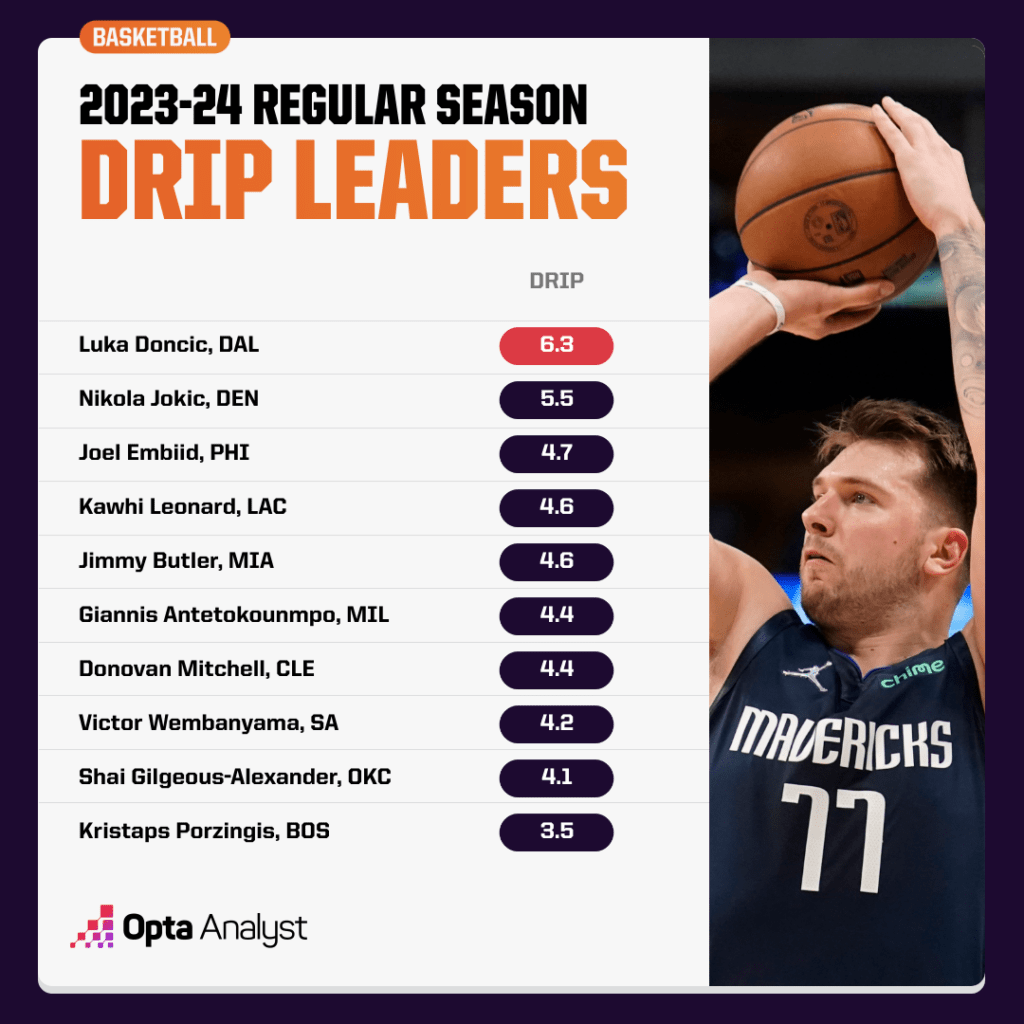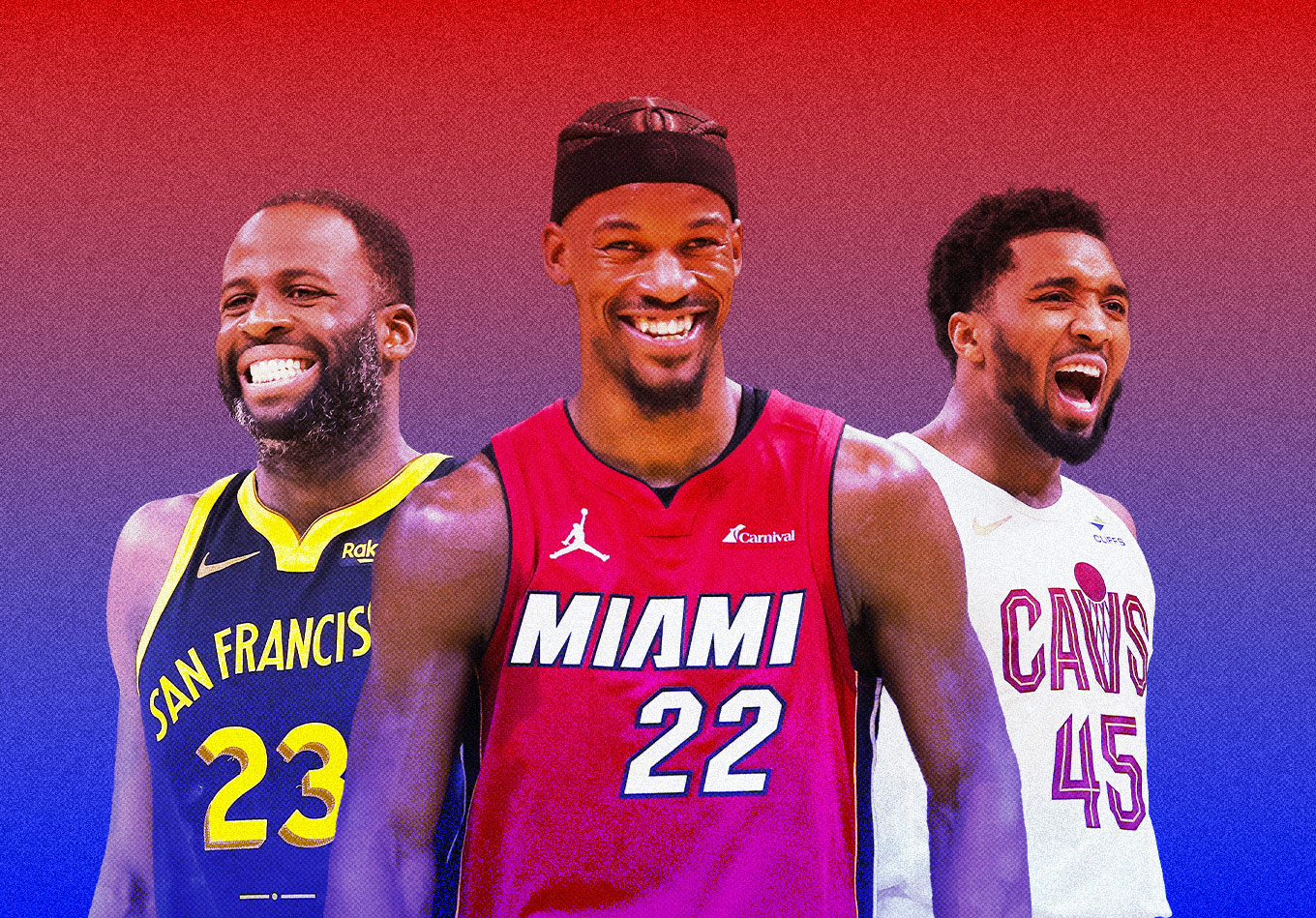In the last four years, the conference finals have included at least one team with a 4 seed or lower. Who will emerge as this year’s Miami Heat?
One of the most captivating storylines of last postseason was how the Miami Heat went on a Cinderella-esque run, going all the way from the play-in tournament to the NBA Finals.
However, their run isn’t as unprecedented as it initially seemed. In fact, in each of the last four years, the conference finals have included at least one team with a 4 seed or lower.
If history repeats itself (as it tends to do), this year, we will have at least one team not currently ranked in the top three in the conference’s standings fighting for a chance to play for the title.
But which team is the best position to be this year’s party crasher?

What Fueled Miami’s March
Many people point to luck as the culprit for Miami’s deep postseason run. And to be fair, the Heat did shoot 45.0% and 43.4% from 3 in their series upsets over the top-seeded Milwaukee Bucks and second-seeded Boston Celtics, respectively, after shooting 34.4% during the regular season.
But what is it that Harvey Dent said in The Dark Knight? Oh yeah, “you make your own luck.” Yes, Miami was the beneficiary of shooting luck in its victories. But the Heat also stacked the deck in their favor by arming their roster with combustible marksmen like Max Strus and Duncan Robinson, who can erupt at any given moment.
Along with that, they also had stars with a history of strong performances in the postseason. We’ve all heard the fables of Playoff Jimmy (the moniker bestowed upon Jimmy Butler), and Bam Adebayo’s defensive versatility makes him one of the most dangerous postseason defenders on the planet (he’s also fifth in the NBA in defensive DRIP).

Miami also housed a roster that was capable of playing multiple different styles.
Butler and Adebayo were the foundation, Strus and Robinson were the shooters (Strus was also a sound perimeter defender), Gabe Vincent was a pesky point-of-attack defender with a dangerous pull-up jumper (88th percentile in midrange percentage in 2022-23) and Kyle Lowry was an older version of that with less speed and more guile. Haywood Highsmith was their defensive wing-stopper, Kevin Love was a stretch 5 who provided additional value as an outlet passer and charge drawer and Cody Zeller gave them additional size and rim protection. And then there’s Caleb Martin, who was so good at being a do-it-all role player that he nearly won the conference finals MVP over Butler.
The last thing the Heat had going for them was their physicality. You always hear people say that the postseason is officiated differently than the regular season. That is generally true. And Heat Culture is built for this extra physicality.
In their first-round rout of the Cleveland Cavaliers, the New York Knicks posted an offensive rebounding percentage of 34.9%. But when they were eliminated by the Heat in Round 2, that mark dwindled down to 27.2%. That’s because Miami did a better job of battling for rebounds and keeping them from getting second-chance opportunities (a strong indicator of physicality).
All this gives us four factors that we can use to compare last year’s Heat team to potential underdogs this season:
- The presence of dynamic (or at least extremely streaky/volatile) shooters
- Stars with a history of strong playoff performances
- A roster that breeds potential for versatile lineups
- A rotation that can play physical
Now, here are five teams that could follow in the 2023 Heat’s footsteps this season. (And check out my personal picks on Instagram.)
(Sidebar: For this exercise, I won’t be considering the Philadelphia 76ers. They were trending toward being a top-three seed in the East before Joel Embiid’s injury. So, it felt like including them would kind of be cheating.)
Who Fits the Bill?
1. Los Angeles Lakers
- Adjusted Offensive Rating: 15th
- Adjusted Defensive Rating: 17th
- Adjusted Team Rating: 17th
- Chances of Making NBA Finals: 0.8%
The Case for the Lakers: Some could argue the Lakers are getting some big market bias, but they may have the strongest case of (almost) anyone of meeting all four of the factors we outlined above. Shooting/spacing has always been a concern for them (tied for 28th in 3-point attempts). But they do have D’Angelo Russell, who has been shooting 43.0% on 8.7 3s per game since the turn of the new year. As for their firepower, LeBron James and Anthony Davis have as much playoff pedigree as almost any other duo that could be (remember, the Lakers still need to get through the play-in) in the postseason this year. Alongside James and Davis, they have offensive creators (Russell, Austin Reaves, Gabe Vincent and Spencer Dinwiddie), defensive-first wings/forwards (Taurean Prince, Cam Reddish and Max Christie), bigs who can give Davis a breather (Jaxson Hayes and Christian Wood), and a do-everything proven playoff performer (Rui Hachimura). As for physicality, you’d be hard-pressed to find a frontcourt trio that matches the size and strength of James, Davis and Hachimura.
2. Golden State Warriors
- Adjusted Offensive Rating: 6th
- Adjusted Defensive Rating: 16th
- Adjusted Team Rating: 8th
- Chances of Making NBA Finals: 2.5%
The Case for the Warriors: The Warriors are 27-14 since Draymond Green returned from suspension, and they are looking pretty good in most of the four factors. In terms of shooters (the first factor), I think the employer of The Splash Brothers is good to go there. Stephen Curry, Klay Thompson and Green have all been integral parts of four championship runs (second factor, check). Their depth (third factor) after those three holds up with pretty much any team they could potentially matchup with. The Warriors are the only team in the NBA to tout 10 players with a DRIP of minus-0.5 or higher (as of April 11). The worry here is their physicality. With classical bigs coming back in style and Green (6-foot-6) as your nominal center, it makes it harder to handle teams with more size. One of the main reasons they lost to the Lakers last year is because they struggled to match their size (without sacrificing spacing). The good news is that Jonathan Kuminga’s emergence (DELTA in the 94th percentile) means that he can aid them in this category in a way he couldn’t last year.
(Sidebar No. 2: DELTA measures a player’s change in DRIP from the start of the season until now, making it the perfect metric to track how much a player has improved/declined this year.)
3. Cleveland Cavaliers
- Adjusted Offensive Rating: 20th
- Adjusted Defensive Rating: 9th
- Adjusted Team Rating: 19th
- Chances of Making NBA Finals: 2.2%
The Case for the Cavs: The Cavaliers made it a priority to add more shooting this offseason (Strus, Georges Niang and Sam Merrill). As a result, their 3-point attempts per game has gone from 24th in 2022-23 to eighth this year. Their Big 4 struggled last postseason, but a lot of that was a byproduct of their poor spacing, the Knicks being a bad matchup, and Darius Garland/Evan Mobley/Jarrett Allen’s shared inexperience (that led to the lights being too bright). Plus, Donovan Mitchell has a history of being a massive playoff riser (meaning his game improves in the postseason). From 2019-21 (17 games), Mitchell averaged 2K numbers in the game’s second season – 33.9 points and 5.2 assists on 64% true shooting. As for their lineups, we’ve examined the odd fit between the members of the Big 4 in the past. But having a lot of talent that doesn’t necessarily mesh together perfectly isn’t the worst problem to have. When Cleveland needs size, it can go twin towers with Mobley and Allen. When they need extra offense, the Cavs can give Mitchell and Garland big minutes. If they need more balance, they can go with Mitchell/Allen and role players or Garland/Mobley and role players. That’s a lot of different looks you can explore in a playoff series. Earlier, we cited this team as the poster child for getting bullied in the postseason. So, physicality isn’t really in the Cavs’ favor. The saving grace here is that Dean Wade and Isaac Okoro have taken some leaps, and the roster now has some Heat Culture toughness (Strus). Hopefully, these improvements will dim the lights for them a little.
4. Dallas Mavericks
- Adjusted Offensive Rating: 7th
- Adjusted Defensive Rating: 12th
- Adjusted Team Rating: 6th
- Chances of Making NBA Finals: 12.3%
The Case for the Mavs: The Mavericks are second in the NBA in 3-point attempts per game. When you take that many, there’s a chance you might get burned (see the 2017-18 Houston Rockets). But you also may get sizzling hot. If that happens, Dallas could steal a couple of games in a playoff series that it probably wouldn’t have otherwise. The Mavs’ star power speaks for itself in the form of Kyrie Irving (author of one of the greatest shots in NBA Finals history) and Luka Doncic (who legitimately looks like Michael Jordan out there sometimes). Doncic is also the league leader in DRIP metric (is this the year he wins MVP?). The Mavericks have also done well to acquire a cavalcade of role players to flank Doncic/Irving. Similar to the Lakers, they have offensive-first guards (Tim Hardaway Jr. and Jaden Hardy), defensive-first wings/forwards (Derrick Jones Jr. and Dante Exum), a do-it-all forward (PJ Washington), a shot-blocker who can stretch the floor (Maxi Kleber), and two bigs who can safeguard the paint and play pick-and-roll with Doncic (Daniel Gafford and Dereck Lively II). Like many of these teams (outside the Lakers and our last candidate), Dallas is lacking in size/physicality. Adding Gafford and Washington at the trade deadline certainly helps with that, but the Mavericks still don’t have a good answer for the bigger brutes in the West (like Nikola Jokic and Davis).

5. Miami Heat
- Adjusted Offensive Rating: 21st
- Adjusted Defensive Rating: 4th
- Adjusted Team Rating: 14th
- Chances of Making NBA Finals: 2.7%
The Case for the Heat: You knew we couldn’t leave this year’s Heat off this list. No explanation is really needed here (because we basically already did earlier). But we will add that while Miami did lose some shooting in Strus and Vincent, it still has Robinson (who is arguably better than ever), and now a healthy Tyler Herro. The Heat also have Jaime Jaquez Jr., Terry Rozier and a more polished version of Nikola Jovic (91st percentile in DELTA).
Enjoy this? Check out our MLB, NBA and NFL coverage, and follow along on X and Instagram for more.
